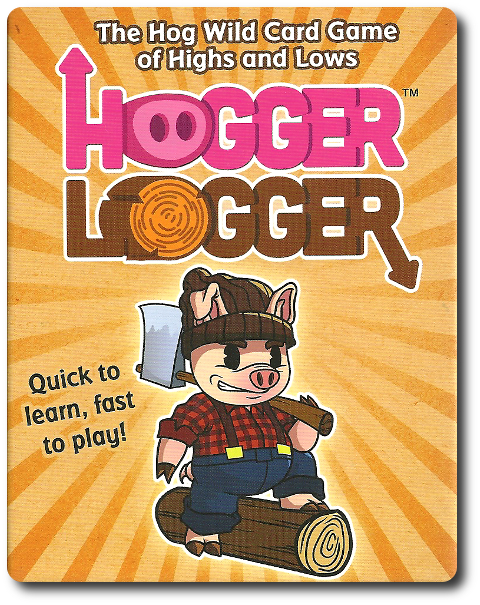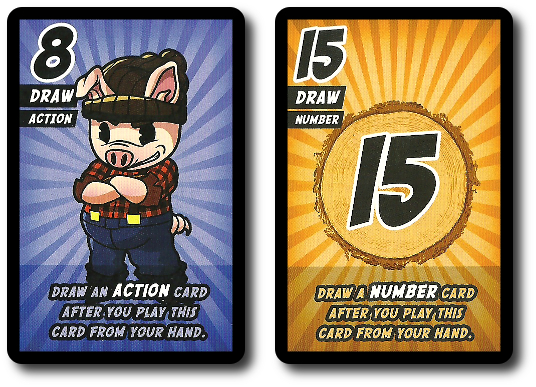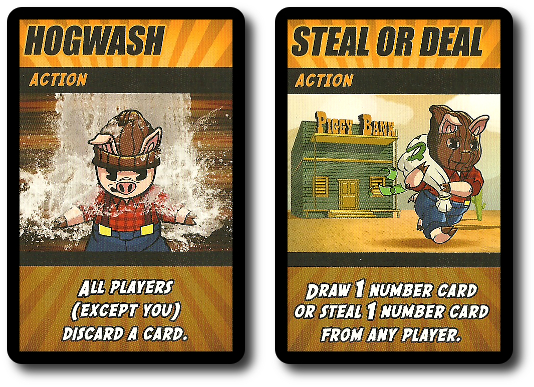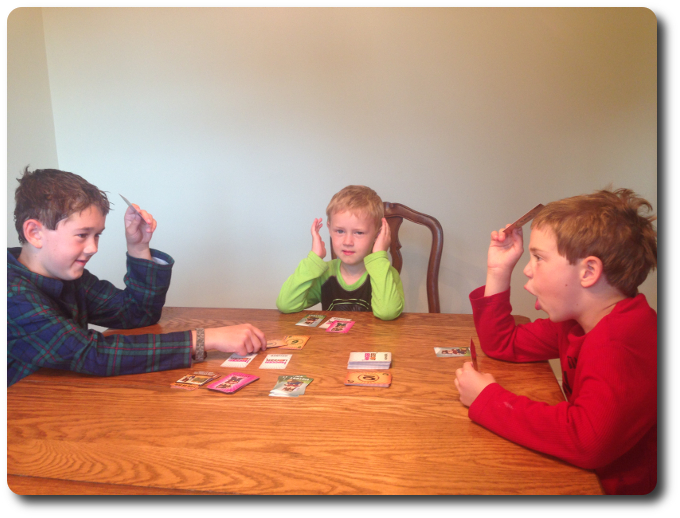
The Basics:
- For ages 6 and up (publisher suggests 7+)
- For 2 to 6 players
- Approximately 20 minutes to complete
Geek Skills:
- Active Listening & Communication
- Counting & Math
- Logical & Critical Decision Making
- Reading
- Hand/Resource Management
Learning Curve:
- Child – Easy
- Adult – Easy
Theme & Narrative:
- None
Endorsements:
- Gamer Geek rejected!
- Parent Geek mixed!
- Child Geek approved!
Purchase:
Overview
Greek philosopher and mathematician, Plato, said “A good decision is based on knowledge and not on numbers.” An agreeable point of view that is not always possible to achieve. Sometimes we have to make choices based on instinct and assumptions, hoping that luck, not knowledge, is on our side.
Hogger Logger, deigned by Shawn Duenas, Ryan Shapiro, Charlie Winkler, and published by Hogger Logger LLC, is comprised of 75 Number cards, 25 Action cards, and 7 Victory cards. The cards are as thick and as durable as your standard playing card. The illustrations by artist Christian Jang are colorful and cartoonish, adding a fun bit of flair.
Game Set Up
To set up the game, first separate the deck into 3 different card types: Number, Action, and Victory cards. Set the Victory cards to the side.
Second, shuffle the Number and Action cards separately, placing each deck face-down in the middle of the playing area. These are the Number and Action draw decks for the duration of the game.
That’s it for game set up. Determine who the first Guesser will be and begin.
Hoggin’ and Loggin’
Hogger Logger is played in rounds with no set number of rounds per game. A round of game play is summarized here.
Step 1: Set the Number
Draw the top 4 Number cards and place them in a row, face-down, making certain none of the players see the Number card values. Then draw a 5th Number card and place it face-up directly below the line of face-down number cards. This face-up Number card is referred to as the “Current Card”.
Finally, deal each player 3 Number cards. This is the player’s hand for the round. Cards in a player’s hand should be kept hidden from opponents until played.
Step 2: Go High or Go Low
The round’s Guesser must now announce if they think that one of the face-down Number cards values is lower or higher than the Current Card value. This is done by simply saying “High” or “Low”. The Guesser need not say how high or how low. A Number card value could be anywhere between “1” and “15”. Therefore, if the Current Card value is a “14”, the odds are very good that the value of any face-down Number card is lower.
However, the Guesser and the Guesser’s opponents can play Number cards from their hand on top of the Current Card. The played Number card becomes the new Current Card and the Guesser must now reevaluate their guess. Number cards can be played at anytime and the Guesser can always change their guess before revealing a face-down Number card. Before doing so, however, the Guesser must always give their opponent’s an opportunity to play Number cards to change the Current Card value.
Step 3: Reveal
After the Number cards are played and the Guesser gives everyone one last chance to change the Current Card value, they again announce their guess and reveal any face-down Number card in the row.
- If the guess is correct, the revealed Number card becomes the new Current Card and the Guesser goes again.
- If the guess is wrong, the next player in turn order sequence becomes the new Guesser and all players with ZERO (“0”) cards in their hand draw 1 Number card. A revealed Number card that is equal to the Current Card value is considered an immediate fail. The revealed Number card becomes the New Current Card.
Do not refill the row of face-down cards.
Special Numbers and Actions
Some Number cards have a special Draw action that will either allow a player to immediately draw 1 Number card or immediately draw 1 Action card, adding the drawn card to their hand. The player must complete the Draw action before playing another card. A player can also earn 1 Action card by playing a Number card with the same value as the Current Card. This is referred to as “matching up”. If the player has 2 or more Number cards that can match up to the Current Card value, they can play all the matching cards at the same time, receiving 1 Action card per card played. Additionally, if a player plays a Number card with a Draw action that allows them to draw 1 Action card and the Number card value matches the Current Card value, the player can draw 2 Action cards.

Action cards can be played whenever the player likes during the game. Once played, the Action card must be resolved before any other cards can be played. Essentially, Action cards temporarily pause the game. Once played and resolved, the Action card is discarded into a discard pile next to the Action draw deck. Players are never forced to play an Action card, but they do count towards the player’s 3 card hand limit. Action cards allow the player to draw more cards, steal cards, mess with opponents’ cards, and other nasty little surprises that will keep players on their toes.

You will both love and hate Action cards…
Lumber Jacked
As the round continues, different players will take turns being the Guesser. The only guess that really counts, however, is the last one. The player who correctly guesses the last face-down Number card in the row receives 1 Victory card. The round is then reset. All the played Number cards are placed in a discard pile. All unplayed Number cards in the players’ hands are also discarded. Any Action cards not played go to the Action discard pile. A new round is then dealt using the game set up instructions. The next player in turn order sequence is the round’s new Guesser.

It’s very possible that the final face-down Number card is not earned right away, with one or more Guessers incorrectly guessing the high or low odds. The new Guesser is always the next player in turn order sequence. The revealed Number card becomes the new Current card and the topmost card on the Number draw deck is placed face-down in the row.
Hogging Victory
The game continues until a player has earned enough Victory cards to win the game. The number of Victory cards required to win is dependent on the number of players.
To learn more about Hogger Logger, visit the game’s website.
Final Word
The Child Geeks got into the game right away, finding it fun to raise and lower the Current Card values and harassing each other with Action cards. According to one Child Geek, “My favorite thing to do is change the number at the last-minute just to mess with the Guesser.” And mess they did. Another Child Geek said, “This game can be really hard because the numbers keep moving about really fast.” Yes, they do, but the only number that ever matters is the Current Card value. What came before it is no longer of any concern. This made it easy to guess, but the constant changes made some of the younger Child Geeks feel a bit stressed, but not frustrated. The source of the real frustration came from bickering siblings, rather than changing number values. When all the games were over, the Child Geeks voted to approve Hogger Logger.

My youngest Child Geek rolls his eyes while his older brothers bicker over the Current Card value
The non-gamer and inexperienced Parent Geeks found Hogger Logger to be a fast and fun game. According to one of these Parent Geek, “The number is always changing and you can feel the tension build right before the card is flipped! It can feel pretty intense sometimes!” But not all the Parent Geeks thought so. The more experienced Parent Geeks, who had played many more games than their non-gamer counterparts, found Hogger Logger to be somewhat slow. Some even used the word “boring” to describe it. According to one of these Parent Geeks, “I feel that all I am doing is guessing. Worst yet, the majority of guessing doesn’t matter because only the last card in the round counts as a victory point.” A clear split with the Parent Geeks, but they unanimously agreed that Hogger Logger was a game they enjoyed playing with their Child Geeks. The Parent Geeks gave Hogger Logger a mixed endorsement.
The Gamer Geeks did not care for Hogger Logger one bit. Some of them even became angry and belligerent whilst attempting to guess a high or low value. According to one of the calmer Gamer Geeks, “This game is horrible. All you are doing is guessing high or low. You might throw in an Action card, but what’s the point? There is no point. I’m dumber for playing this game.” Another Gamer Geek said, “This is not a good game, in my opinion. Or, to be fair, not a good game for people who enjoy games.” The repetitive game play, inability to use any semblance of tactics or strategy, and lack of depth made Hogger Logger a game none of the Gamer Geeks would endorse or would ever want to play again.
Personally, I don’t care for Hogger Logger because it’s just a guessing game. You could have the exact same game experience with a standard deck of playing cards. In fact, the game Hi-Lo (also know as High-Low) is Hogger Logger without the Action and Victory cards. You can play a variant of this game in Las Vegas for money if you like to gamble. None of which is bad, mind you, but I find nothing interesting about guessing over and over again. Hogger Logger isn’t so much a card game as it’s a guessing game that uses cards. That can get old.
But nor is the game a complete waste of time, as the Gamer Geeks would have us believe. The Action cards provide a brief reprieve from the monotony of guessing “high” or “low” turn after turn, round after round. As I mentioned, you will come to love and hate the Action cards during the game. They mess things up, but they also shake things up, giving players something new to do and to think about. The other saving grace is the ability to adjust the Current Card value. If “8” is considered the halfway point between high and low, a player can adjust the values and thereby tip the scales in their favor. Of course, so can everyone else. This makes the game something of a teeter-totter, but smart use of Number and Action cards gives the player more control.
Hogger Logger is a game I would eagerly recommend to the Child Geeks and the non-gamer Parent Geeks. This is a game I would never put in front of a gaming elitist out of fear they would beat me up. From a Gamer Geek’s point of view, this is not a game. I know that sounds mean and even stupid (because, after all, Hogger Logger is a game), but a Gamer Geek has certain criteria that their games must meet before they are considered “a game”. Hogger Logger doesn’t even come close to making the grade, as our observations prove. For everyone else, Hogger Logger will entertain, if not delight.
This game was given to Father Geek as a review copy. Father Geek was not paid, bribed, wined, dined, or threatened in vain hopes of influencing this review. Such is the statuesque and legendary integrity of Father Geek.



